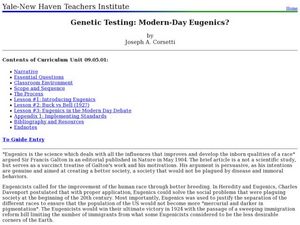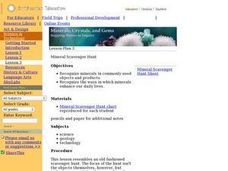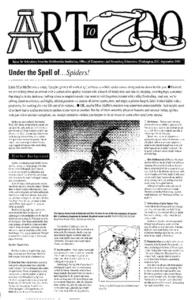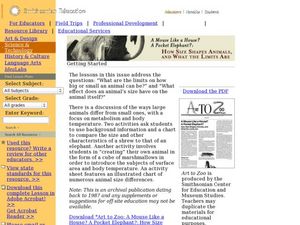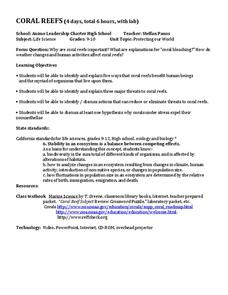Smithsonian Institution
Watching Crystals Grow
Amazing science can sometimes happen right before your eyes! The class gets cozy as they watch crystals grow. They use Epsom salts, rocks, and food coloring to create crystals. They'll observe the entire process, documenting every step...
Curated OER
The Beagle Brigade
Young scholars develop an understanding of animal behaviors through reading a case study about detector beagles. They explore the interaction of innate abilities and learned behaviors.
Curated OER
Disperse or Decrease
Students explore the dispersal of animals.. Students take on the role of a specific animal. They simulate finding a new home due to overpopulation. Through hands-on activities performed during the simulation, students discover the area...
Curated OER
Scientists Write!
Students use a journal to record observations. They make notes about what research may be needed to answer questions that have come up in the field and sketch or make connections in the curriculum. They research bioinformatics and...
Curated OER
Population Ecology
Here are some ideas to help students understand population growth in ecosystems.
Curated OER
The Physics of Flight
Students discuss how the invention of flight changed the way people live today. In groups, they compare and contrast the differences between weight, lift, thrust and drag. Using these principles, they create a glider and propeller with...
Curated OER
Genetic Testing: Modern-Day Eugenics?
Students trace the history of the development of Eugenics. In this social studies lesson, students read and analyze a real life case. They write a paper about what they read.
Curated OER
Plants and Animals: Partners in Pollination
Students describe the complementary relationships between pollinators and the plants they pollinate, identify adaptations that flowers have developed to "encourage" pollination, and create and draw their own "designer" flowers.
Curated OER
Mineral Scavenger Hunt
Students complete a scavenger hunt worksheet as they find examples in their classroom, at home, etc., of minerals. Excellent worksheet!
Curated OER
Create a Classroom Exhibit: Rocks and Minerals
Young scholars bring in rocks and minerals from home. They observe them and describe them carefully, completing a worksheet. Finally, a classroom exhibit is created.
Curated OER
Plants and Animals, Partners in Pollination
Students participate in multiple hands-on activities to explore reproduction and pollination. In groups, using a cotton swab and powder, students simulate being pollinators and plants. They name the parts of the flowers and the function...
Curated OER
Rocks and Minerals
Learners bring rocks and minerals from home to investigate in the classroom. In this rocks and minerals lesson plan, students observe all the rocks and minerals brought into the class and answer 7 questions about the features of the...
Curated OER
Under the Spell of Spiders
Young scholars examine spiders. In these spider lessons, students will view spider images and live spiders to determine physical characteristics, habits, and habitats. Young scholars will examine fantasy and folklore about spiders to...
Curated OER
"ART ZOO 'Blacks in the Westward Movement', 'What Can You Do with a Portrait', and 'Of Beetles, Worms, and Leaves of Grass'"
Students study black history, examine portraits and portrait making and create their own portraits, and investigate their natural environment. This humanities activity provides a text that can be used to teach lessons in black history,...
Curated OER
How Size Shapes Animals
Students investigate how size affects large and small animals differently. In this animal lesson plan, students determine how size affects different animals by constructing their own animal out of marshmallows. Once students create...
Curated OER
Fossils Footprints Across Time
Learners examine fossils to understand how they are formed and how they give information about geological history. In this fossil lesson plan, students research and write about fossils and make models of different fossil types.The PDF...
Curated OER
Going...going...gone? Tropical Rainforests-How They Work, What They Do for Us, What's Being Done to Them...
Sixth graders explore the Tropical Rainforest and come to understand what it is and how it affects the ecosystem. In this rainforests instructional activity, 6th graders write about the Tropical Rainforest, imagine they are in the...
Curated OER
Yuckiest Site on the Internet
Students investigate the worm and the cockroach. In this organisms lesson, students visit suggested websites to identify the characteristics of worms and cockroaches. Students dissect a worm and observe a live cockroach. Students report...
Curated OER
Coral Reefs
Students research coral reefs and identify their benefits to humans, threats to the reef, how to reduce and eliminate threats, and more. In this coral reef lesson plan, students research the reefs, and take a field trip to an aquarium.
Curated OER
World War II: Internment in Hawaii
Learners examine world history by writing an essay in class. In this World War II lesson, students identify the attack on Pearl Harbor, the response from the U.S and the effect it had on Japanese-Americans. Learners define Japanese...
Curated OER
Plant Disease Identification and Classification by Using Sterile Techniques
Seventh graders identify how to use sterile techniques when identifying plant pathogens. In this plant diseases activity students complete a lab activity in which they see how plant diseases are identified and classified.
Curated OER
It's Alive! Using Microorganisms in Cooking
Students create a KWL chart about food. In this chemistry activity, students differentiate physical and chemical changes. They explain how microorganisms are used in food preparation.
Curated OER
Hypothermia on the High Seas
Learners identify and present the effects on humans when the body temperature falls, demonstrate and explain how the body loses heat, and understand hypothermia and cold water survival techniques.
Curated OER
Predator-Prey Simulation
High schoolers simulate the interactions between a predator population of lynx and a prey population of rabbits. They collect and graph the data, then extend the graph to predict the populations for several more generations.
Other popular searches
- American Immigration
- United States Immigration
- 1800 1900 Immigration
- U.s. History Immigration
- Immigration and Urbanization
- 19th Century Immigration
- Illegal Immigration
- Chinese Immigration
- Bureau of Immigration
- Immigration in America
- American Immigration 1800's
- Caribbean Immigration








